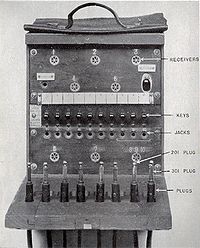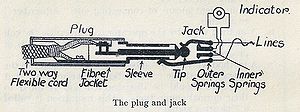Buzzer Switch 7+3
| Buzzer Switch 7+3 | |
|---|---|
 |
Description
39. Telephone exchanges and buzzer switch units[1]
...
4. Buzzer switch units: --
i. When telephones D.III. are in use and a telephone system is required, buzzer switch units are used to establish telephone exchanges; there are two types of switch unit called "4+3" and "7+3." The former can accommodate seven "subscribers" but three of these are grouped on one indicating receiver. The latter can accommodate ten "subscribers," also with three of them grouped on one indicating receiver.

ii. These instruments are similar in many respects. They each have one jack for each "subscriber" and one jack for the operator. One indicating receiver is supplied for each line, except for the last three, which, as mentioned above, have one receiver for the three lines. The lines and "earth" connections are led in through holes on the top of the instrument. The door at the back gives access to the terminal for the lines, earth connections, and the operator's telephone. the action of both these instruments is the same, in that buzzing calls from "subscribers" are received in the indicating receivers and the interconnection of "subscribers" is done by means of cords containing two conductors and fitted with plugs at their ends. The plugs are inserted in jacks.
...
6. Buzzer switch unit 7+3. (Plates V and VI).
i. This instrument has three advantages over the buzzer switch unit 4+3: --
- (a) Three extra "subscribers" can be accommodated.
- (b) More than two "subscribers" can be connected, thus allowing an omnibus circuit to be arranged when necessary.
- (c) Coupling facilities are provided enabling two switch units to be worked together as one exchange. (See end of sub-para. ii, below.)
ii. Each "subscriber's" line has a key associated with its jack. These keys are used in answering a call, calling, and supervising, as well as effecting interconnection with a multi-call.
Normally "subscribers" are interconnected by plugs and cords. The cords have a plug 201 and a plug 301 plug each. The 201 plug leaves the indicating receiver connected to the line into which it is plugged; a clearing signal is thus allowed for, but in practice supervision by means of the keys is necessary to discover when the lines are clear.
The keys have three positions and their use is as follows:--
Position of the key Connections made Use "UP" The key remains locked. The subscriber's line is connected through the common bar to the operator's instrument. The subscriber's jack is cut out. For calling a subscriber, and allowing an omnibus call by placing two or more keys in the "UP" position "DOWN" The key does not lock and must be kept pressed. the operator's instrument is now 'teed-in" to the subscriber's jack circuit. For identifying a call, i.e. by pressing keys in turn. For supervising, i.e. bringing the operator into circuit without interfering with a conversation. "HORIZONTAL" The common bar is disconnected, the line being connected direct to the jack and indicating receiver. The normal position when waiting for a call or while a single conversation is in progress.
In order to couple two switch units together, the coupling terminals of the first unit are joined to the operator's terminals of the next and the coupling key of the first unit is put up. The two units can then be used as one by one operator.
iii. The procedure for operating the switch unit 7+3, is contained in Sec. 82.
Operating Instructions
82. Operating instructions, buzzer switch unit 7+3[1]
1. Normal calls. -- The "subscriber" attracts the attention of the exchange operator required by pressing the key of his telephone continuously until answered. Unless a distinguishing call has been allotted to each "subscriber," the calling line must be identified by the operator, who presses down each key in turn till the call is heard in his own instrument. The exchange operator then holds down the key associated with the calling line in the DOWN, or "answer and speak," position and if necessary stops the "subscriber's" call by pressing the key of his exchange telephone. Still keeping the key in this position, the operator answers the call by saying ". . . exchange speaking, sir." The "subscriber" then says, for example, ". . . (unit, officer, o0r code name) please." The operator repeats the name of the unit, etc. required and pauses a moment in case the "subscriber wishes to make a correction. If the line to the required "subscriber" is disengaged, the operator will say 'one moment, please." He then inserts one plug o a cord into the "jack" associated with the calling "subscriber's" line and the other plug of the same cord into the "jack" of the required "subscriber's" line. The operator then puts the key associated with the required "subscriber's" line into the UP. or "call and speak," position and calls on his exchange telephone.
On obtaining a reply the operator puts the connection through by turning down the key of the required "subscriber's" line and holds this key in the DOWN, or "answer and listen," position until the conversation begins. The key is then released.
If the line to the required "subscriber" is already in use, the operator will inform the calling "subscriber" by saying "line engaged, sir."
As is is difficult, with this switch unit, to identify a call "clearing signal" (i.e. "ring-off"), the operator must supervise calls by pressing the key, associated with that line, into the DOWN position. If no conversation is heard he challenges by saying "finished?" three times. If there is no reply he will clear the connection by withdrawing the plugs. Any waiting call can then be put through.
2. Multiple calls.
i. If a "subscriber" wishes to speak to a number of other "subscribers" simultaneously, the operator calls each required "subscriber" in turn, and says, "multiple call for your, sir; one moment, please," returning each key to the NORMAL (or horizontal) position. When the operator has obtained all the required "subscribers," he turns the keys of the caller and required "subscribers" to the UP (or "call and speak") position and says, "through, sir." The operator listens until the conversation begins and then inserts a plug in the "jack" marked "operator," this disconnecting the operator's instrument from the multiple call connection. The operator can supervise the multiple call by withdrawing the plug from the operator's "jack" and listening on his telephone.
ii. If, while such a multiple call is in progress, another call is received, the calling line must be identified by the operator, unless a distinguishing call has been allotted to each "subscriber." The keys on the switch unit must not be used for this purpose while the multiple call is in progress; the identification must therefore be carried out by some other method. The operator can do this by placing his thumb or finger over each receiver in turn to discover which receiver is in action. The plug at the free end of the cord which is already connected to the operator's "jack" is now inserted in the "jack" associated with the calling line. Having ascertained the "subscriber" required, the operator removes the plug from the calling line and inserts it in the "jack" of the required "subscriber." The required "subscriber" is then called by pressing the key of the exchange telephone. When the required "subscriber" answers, the operator removes the plug from the operator's "jack" and inserts it in the "jack" of the original caller, thus completing the connection.
3. A modified form of buzzer switch unit 7+3 (Mark II) has been prepared, with various improvements. The principle difference is that when in the DOWN position, the keys do not connect with the common bar used in the UP position, but with another bar. Hence a key can be used for answering a call even with the UP position common bar is in use for a multiple call.
Photos
Related Pages
- No related pages at this time
Related Items
References
- ↑ 1.0 1.1 extract from "Signal Training (All Arms) 1932"

